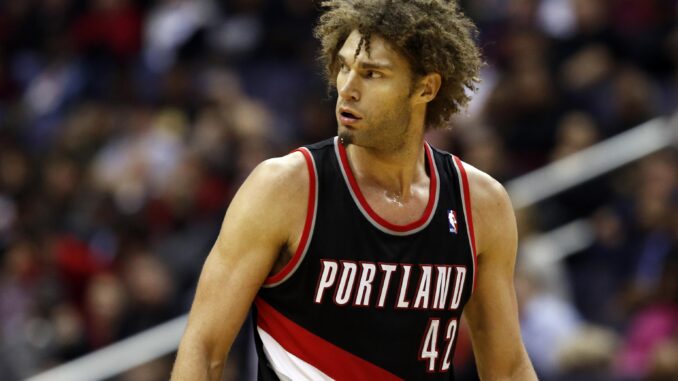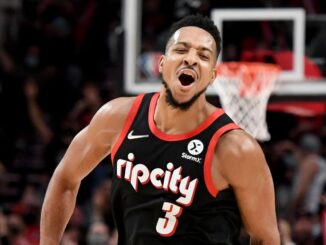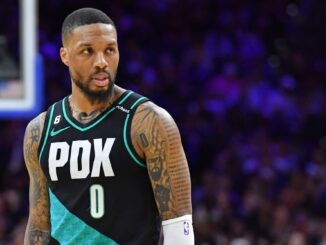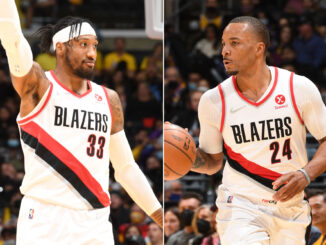
The Portland Trail Blazers have had plenty of characters stop through Stumptown during their 54-year history.
If you grouped the ghosts of Rip City’s past, you’d tier together NBA Legends like Bill Walton, Clyde Drexler, and Damian Lillard. After that, there’d be Blazers Legends in their own right, like Geoff Petrie, Clifford Robinson, and, obviously, Steve Blake.
Portland has also had more than a few Legends of Controversy over the years. And yes, we’ll get to them, too, during our week-long, five-part Oregon Sports News Top 50 Trail Blazers Player Rankings reveal.
The Goal
Oregon Sports News set out to create the ultimate Top 50 Portland Trail Blazers all-time player rankings.
This was a group effort. No one person decided these rankings. Each participant played an equal part in building a collective, authoritative list that will remind fans how rich this franchise is with fan favorites.
The Method
OSN asked nine participants* to rank their personal Top 50 All-Time Trail Blazers from No. 1 to No. 50.
The final list was calculated after applying a point value to each vote.
*A special thanks to every OSN voter: Arran Gimba, Casey Mabbott, Jared Wright, Nick Bartlett, Ben McCarty, Reese Kunz, John Howard Friemark, Mo Damtew and Bryant Knox.
Criteria
Criteria were subjective from voter to voter.
All participants considered individual stats and accomplishments, team success, player durability, peak performance vs. longevity, and overall impact on the locker room and community.
Nobody was instructed to weigh categories any particular way; each voter decided which categories weighed the most during their process.
*Final Note: All criteria listed above and stats listed below apply only to a player’s time in Portland.
Portland Trail Blazers Top 50 All-Time Player Rankings
50. Robin Lopez, C
Years: 2013-2015
Games Played: 141
PPG: 10.5
RPG: 7.8
APG: 0.9
BPG: 1.6
HI RK: 34
LO RK: Unranked
Robin Lopez wasn’t in Portland for a long time, but the 7-footer made sure it was always a good time—at least, if he had any say in the matter.
Lopez was a key cog in the NBA’s most productive starting lineup for two crucial seasons. It was kind of unreal how good and fun this team was with Damian Lillard, Wes Matthews, Nicolas Batum, LaMarcus Aldridge, and Sideshow Bob.
RoLo’s reputation around the league (or at least his social media presence) centered around his quirky, fun-loving, “Keep Portland Weird” nature, as well as his many rivalries with mascots. (No fluffy creatures were ever fluffy enough to avoid a pre-game beatdown.)
In Portland, though, RoLo was an unsung hero on a roster featuring Lillard and Aldridge. He was a glue guy and a bruiser on a team that was, maybe, a Wes Matthews Achilles tear away from making real noise, and he never lacked effort, even as the ship was going down.
*At No. 50, Lopez beats out Darnell Valentine and Al-Farouq Aminu (T-51), as well as Gerald Wallace (53), Ruben Patterson (54), and Theo Ratliff (55) for the final spot in our ranking.
49. Dave Twardzik, PG
Years: 1976-1980
Games Played: 280
PPG: 9.5
RPG: 2.2
APG: 3.4
SPG: 1.4
HI RK: 33
LO RK: Unranked
Although Dave Twardzik isn’t a household name in Rip City, he’s the first Blazers champion on our list.
Quite frankly, Twardzik was the ideal Jack Ramsay point guard. He never prioritized plays for himself or even for specific teammates, instead looking and creating for anyone in the right spot.
As OSN’s Casy Mabbott puts it: “Twardzik simply had to be on this list. He is on a select list of Portland Trail Blazers to be a regular starter for a championship team and a key contributor. He could score, he could pass, he could steal, he could do it all.
“Like Sex Panther cologne, his shots worked 60 percent of the time, every time.”
That’s just the math, folks.
We don’t question the numbers. We don’t make the rules.
48. Joel Przybilla, C
Years: 2004-2011, 2011-2012
Games Played: 422
PPG: 4.7
RPG: 7.1
APG: 0.5
BPG: 1.5
HI RK: 31
LO RK: Unranked
Portland has never been a free-agent destination, but in 2004, Joel Przybilla moved west to join Rip City, where he’d spend the next six-and-a-half seasons.
Over that half-decade-plus, “The Vanilla Gorilla” earned every bit of his status as a fan favorite. He was grit-and-grind before the Memphis Grizzlies even knew what that was. And with a nod to Maurice Lucas, who was “The Enforcer” before him, Przybilla embodied physicality and fortitude better than most have in modern franchise history.
At the end of the day, Portland traded Przybilla to the Charlotte Hornets in 2011—a deal that would help define the Blazers’ next decade.
Portland included two first-round picks to acquire Gerald Wallace. And, of course, after a year of that experiment, “Crash” was off to the Brooklyn Nets for the 2012 pick that would become Damian Lillard.
47. Kenny Carr, PF
Years: 1982-1987
Games Played: 316
PPG: 12.4
RPG: 8.1
APG: 1.5
SPG: 0.7
HI RK: 37
LO RK: Unranked
There are plenty of ways to describe the brute nature of Kenny Carr, but I’ll say this: Carr was built to be a 1980s TRAIL BLAZERS power forward.
As OSN’s Jared Wright says: “Carr would initially seem like your usual run-of-the-mill forward from the ‘70s and ‘80s, but did you know he was a top-10 rebounder during his prime despite being only 6’7”?
“Carr also finished in the top 70 in career Defensive Rebounding Percentage and the top 85 in Total Rebound Percentage; no small thing when you realize that over 10,000 men have played in the NBA.”
Unfortunately, like too many Trail Blazers before and after him, injuries played a role in his departure, forcing him to retire in 1987. The difference between him and others, though, is that Carr had a long career spanning a decade, which more than a few Rip City notables were never able to reach.
46. Kermit Washington, PF
Years: 1979-1982
Games Played: 173
PPG: 11.6
RPG: 9.5
APG: 2.0
BPG: 1.3
SPG: 1.0
HI RK: 33
LO RK: Unranked
Kermit Washington’s legacy is mired in controversy. There’s no two ways around that.
The now-infamous power forward makes our list because of his dominant rebounding and efficient scoring during the post-Bill Walton transition. But the truth is, he’d be higher if his reputation weren’t what it is today.
Although best known for knocking out then-Houston Rockets big man Rudy Tomjanovich, Washington also went on to endure post-career legal troubles, including tax evasion and fraud at the expense of charity.
Washington won over fans for a time in Portland, but he’s also tough to put higher on our list, and you wouldn’t have to look hard to find more “deserving” candidates for a top 50 spot in the honorable mentions.
45. Tom Owens, C/PF
Years: 1977-1981
Games Played: 319
PPG: 13.9
RPG: 7.2
APG: 2.5
BPG: 0.6
SPG: 0.5
HI RK: 31
LO RK: Unranked
When fans reflect on the post-championship run, thoughts of Bill Walton’s foot and questions like “what if?” come to mind.
However, folks often neglect how good Tom Owens was for that team.
From OSN’s Ben McCarty: “Tom Owens made a unique impact on the Blazers. He essentially became Bill Walton’s successor, and throughout four seasons, he twice appeared in all 82 games and averaged nearly 19 points per during his first season without Walton, a career-high.”
McCarty continued: “For a team that has struggled to keep big men healthy over the years, Owens was a breath of fresh air.”
Isn’t that the truth? Nobody was going to replace Walton, but the Blazers needed reliability, and Owens gave that to them with more production than most expected.
For that alone, you almost want to see Owens higher on a list like this. But seeing that at least one of our voters placed him at No. 31 makes me feel we got the balance we needed.
44. Sam Bowie, C
Years: 1984-1989
Games Played: 139
PPG: 10.5
RPG: 8.1
APG: 2.6
BPG: 2.5
HI RK: 31
LO RK: Unranked
Sam Bowie was a far better basketball player than he gets credit for.
If you’ve never watched highlights of Bowie, go to YouTube as soon as you’ve finished this article. Few 7’1” centers with his length were as fluid with or without the ball. And that jump shot? It was also legit, as it went beyond the free-throw line, and unless your name was Kareem Abdul-Jabbar, you weren’t blocking that—ever.
All that said, you also know how this story played out.
The team’s first option in the 1984 draft wasn’t actually Bowie at all; it was Hakeem Olajuwon. And when “The Dream” went to Houston following Portland’s lost coin toss, the Blazers were always going to bypass Michael Jordan in favor of Bowie—something that defined Bowie’s entire career, which was to absolutely no fault of his own.
None of that—along with his unfortunate injury history—is anything you can put on him as a player.
Bowie’s spot on this list should’ve been higher. But it’s also clear, based on how fans and media view him today, that very few think the “bust” label is appropriate—not unlike how we view Greg Oden, who unfortunately received no votes during OSN’s ranking process.
43. Dale Davis, C
Years: 2000-2004
Games Played: 331
PPG: 7.1
RPG: 7.2
APG: 1.2
BPG: 0.9
HI RK: 22
LO RK: Unranked
Dale Davis has one of the widest gaps in rankings among our Top 50 players. He settles in here at No. 43 overall, but while he ranked as high as No. 22 by one voter, he also went unranked by two participants.
Of course, part of that likely has to do with his connection to two separate O’Neals. Davis, despite his brute physicality, could never live up to the expectation (or at least the hope) that he’d be a key cog in the collective effort to slow down Shaq. That proved impossible for just about everyone during the era, not just Davis, so you can still give him his props, as OSN’s Arran Gimba does below. But he’s also forever connected to Jermaine O’Neal in the trade that sent Portland’s promising young big to Indiana.
Of course, O’Neal went on to become an All-Star, while Davis played the modest role of bruiser late into his career. But Davis did have a role and held it down.
“Dale Davis did all the dirty work for the Blazers. A tough, blue-collar player who could push the toughest of NBA players, grabbing boards and hitting key shots. Also was a good person, as stated in this article from 2000 from Jason Quick.” — Gimba.
42. Steve Johnson, C
Years: 1986-1989
Games Played: 194
PPG: 14.0
RPG: 1.6
BPG: 0.8
HI RK: 33
LO RK: Unranked
Steve Johnson checks in at No. 42 on our list, and if that feels low, OSN’s Nick Bartlett is with you:
“I feel our group may have ranked Steve Johnson so low because he was only in Portland for a little bit,” Bartlett says. “But that doesn’t negate his 14 ppg, six rebounds, and 54 percent shooting from the field. Johnson also held his own during game 1 of the 1987 playoffs, in which he scored 29 points against Houston’s championship front line. He stepped in as the big man after Sam Bowie, and he excelled in his role.”
In just three seasons, the 6’10” center really did excel in his role. He came to Portland in a trade from the San Antonio Spurs during the 1986 offseason, and for a while, he felt like he could be a franchise fixture at center for a team desperate for exactly that.
Johnson even made the 1988 All-Star Game alongside Clyde Drexler.
On a roster that featured scores aplenty—namely Drexler, Terry Porter, Kiki Vandewegh … you know the squad—Johnson was a comfortable, reliable presence at the rim.
His place on our list could undoubtedly be higher. But also, his place might be fitting as a low-key, high-impact player on those ‘80s teams.
41. Steve Blake, PG
Games Played: 350
Years: 2005-06; 2007-10; 2014-15
PPG: 7.8
RPG: 2.2
APG: 4.5
SPG: 0.7
3P%: .398
HI RK: 32
LO RK: Unranked
When free agent Steve Blake joined the Blazers in 2005, nobody saw what was coming—absolutely nobody.
Blake was a third-year pro coming off a modest two-year stint in Washington to start his career. He had one good season in Portland, starting in 57 of his 68 games, recording 8.2 points and 4.5 assists while shooting 41.3 percent from deep.
It’s safe to say the 6’3” point guard became a fan fave quickly. But when he was flipped in a deal for center Jamaal Magloire just a year later, there was no reason to believe he’d ever be one of the more beloved Trail Blazers of the era.
Today, Blake is a Rip City legend in his own right. After his stint with Milwaukee (and then Denver), Blake returned as a free agent in 2007. He was a mainstay in the starting lineup—and always one of the toughest intimidators on the roster—until 2010, when he was traded again, this time to the Clippers along with Travis Outlaw for center Marcus Camby.
If you thought trading Blake twice would keep him away, you were wrong. The guard signed as a free agent again in 2014, only to be—you guessed it—traded for a center (Mason Plumlee) a year later.
On the court, Blake was fierce. And that’s where I’ll turn it to OSN’s Casey Mabbott:
“It’s so tough not to like Blake. He was such a high-character guy who just did what the team needed. Need a distributor that isn’t selfish? Steve is your guy. Need someone to tutor young players and lead the reserves? Steve is your guy. Need a glue guy who can hit the dagger three or find someone open when the defense is looking somewhere else? Steve is your guy. He was a great Swiss army knife who never stopped being an outstanding teammate.” — Mabbott.



